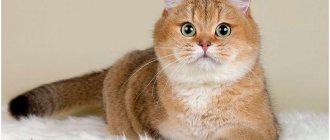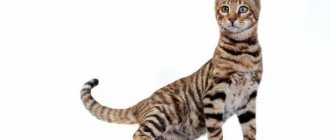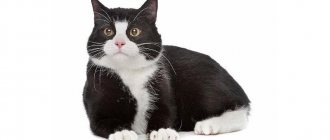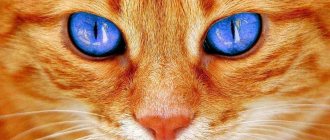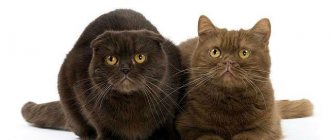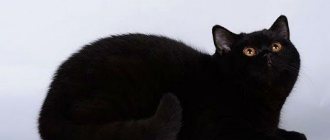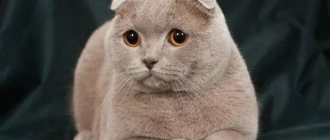Balinese cat
These eyes are opposite...
The second name of the breed is the Balinese cat. Until the 50s of the last century, “Balinese” were considered a long-haired species of Siamese cat. But there was a breeder of the breed who did not agree with this opinion. Helen Smith - that was the woman's name - declared Balinese cats as an independent breed.
Luxurious, long-haired, with huge deep blue eyes - Balinese cats will not leave anyone indifferent. Beauty, coupled with a sweet character, makes the breed a favorite of “cat lovers”. Well, the Balinese have a charming character: cats are talkative, very smart, trainable and affectionate.
Furry breed categories
Cat breeds receive official recognition after passing certification in one of the felinological communities. Animals receive metrics, pedigree and documentary evidence of origin. The exterior must comply with the breed standard. Only a complete package of documents gives the right to selection and participation in exhibitions.
There are more than 700 special species of cats in the world, but international organizations recognize only a few dozen:
- FIFe (World Cat Federation) recognizes 42 breeds.
- European WCF - 70 breeds;
- American CFA Association - 40 breeds.
Breeding work is ongoing, so some resistant phenotypes will periodically receive official recognition.
According to FIFe
According to FIFe, furry varieties include categories I and II, which include the following breeds:
- American Longhaired Curl.
- Balinese cat.
- Burma.
- British.
- Himalayan cat.
- Maine Coon.
- Neva Masquerade.
- Norwegian forest.
- Persians.
- Ragdoll.
- Siberian cat.
- Turkish Angora.
- Turkish van.
- Exotic.
Ragdoll
According to WCF version
According to WCF, furry cat varieties include breeds of categories 1 and 2:
- Long-haired Burmilla.
- Karelian Bobtail
- Kurilian Bobtail.
- Laperm.
- Munchkin.
- Nibelung.
- Oriental.
- Ragamuffin.
- Selkirk rex.
- Somali cat.
- Tiffany.
- Ural rex.
- Highland fold.
- Japanese Bobtail.
Ragamuffin
According to CFA
The CFA recognizes the same cat species as the WCF and FIFe with the exception of: American Bobtail, Ojos Azules, Pixie Bob.
Mekong Bobtail
A very interesting breed
Beauty comes from Asia. Initially, Mekong Bobtails were considered “rejected” Siamese cats. This is due to the unusual, short tail of Asian cats.
Despite its enormous popularity in its homeland, the breed was recognized by the WCF only in 1994. Russian breeders played a huge role in the recognition of Mekong Bobtails. They managed to prove that these cats are distinguished from Siamese not only by their short tail. Animals have completely different body types.
Representatives of the breed, for the most part, have rich blue eyes, a mischievous character and affection for the owner.
Buy a Russian blue kitten
global $ads_google;
//data-ad-slot=”2475549904″ $ads_google = empty($ads_google) ? false : true; ?> if ($ads_google == false) {?> $ads_google = true; ?> } ?> At the moment, everyone who wants to buy a Russian Blue kitten from a cattery can do so in Russia, Belarus, Ukraine and other countries. It is only important to choose healthy babies no younger than three months of age. In this case, they will grow into healthy, strong and beautiful cats, fully vaccinated and meeting the breed standard.
The price of a Russian blue cat ranges from 8,000 to 40,000 rubles
.
The cost depends on many factors, such as:
- Parents title
- Eliteness of the nursery
- Territoriality
- Full compliance with the standard
- Much more
What to name a Russian blue kitten
And now, a little bundle of happiness has appeared in your home.
You have already purchased toys, a toilet, a house for him and stocked up on food. But they still couldn’t figure out what name to give the kitten. Russian blue cats have nicknames associated with their color or eye color, as well as their history of origin and character traits. Nickname table
| Girl | Boy | ||
| Masya Blanca Sonya Fairy Rusya Taira Kusya Izya Veta Yesya Runa Tuchka Greya Roxy Lesya | Tensi Haze Tsiana Ilya Stella Sofia Klyopa Grau Cleo Christy Zvezdochka Asta Grinya Basta Moska | Emerald Sirius Porter Freak Blue Pitty Quartz Fanya Zubastic Dodger Eraser Indie Chip Bucks Antey | Frank Lucky Harvey Gray Ivanhoe Ike Karay Citron Willie Bentley Cosmos Sirius Harrison Murchik Charlie |
Oriental cat
They look like aliens
Improved breed from Siam (Thailand). Magnificent cats, for a long time, were “closed” from the world, living in the temples of Thailand. Only in the 19th century did the world learn about the “overseas” beauty.
Today, the Oriental cat is one of the most popular in the world. The unusual color and blue eyes give the animal a special cuteness. There is an opinion among people that “Orientals” are evil and aggressive monsters. This is complete absurdity, because representatives of this breed are distinguished by extraordinary devotion to their owner, do not tolerate loneliness well and are easy to train.
As for the supposedly viciousness of the breed, any cat is capable of fighting back for itself if it is pissed off. Orientals don’t like familiarity, that’s all.
Cat breeds with blue eyes
Among the breeds of blue-eyed cats, there are the most famous ones, which are popular with both professional breeders and lovers of furry friends.
Siamese cat
The Siamese cat is one of the oldest and most famous representatives of the cat family. It originated from Thailand and quickly gained popularity around the world. Externally, Siamese are very similar to Thai and Oriental cats, but one of the most striking distinguishing features is their bright blue eyes. Siamese also have a long and slender body with pronounced muscles, large triangular ears and a flexible, thin tail. The breed has dark spots on its limbs and face, and its coat color ranges from cream to chocolate.
The Siamese cat is an animal whose appearance creates a general impression of slenderness, lightness and swiftness.
Siamese are proud and self-confident cats that demand attention. They have a fickle and explosive nature and can be either capricious and nervous or loyal and friendly. Despite the fact that Siamese cats become attached to their owners, they have no authority, and therefore their trust is very easy to lose. The Siamese does not like affection, but will happily share active games and walks in the fresh air. There will never be a dull moment with a Siamese cat.
Sacred Burma
The state of Myanmar (formerly Burma) is the birthplace of the Burmese cat. In ancient times, the breed was considered sacred and lived in temples. At the beginning of the 20th century, a millionaire from America imported the Burmese cat to Europe, after which it became widespread. Getting to know Burma is not difficult. This is a semi-longhaired color-point cat with white “gloves” on her paws. The Burmese has a medium-sized body with short legs and a bushy tail, round cheeks, and bright blue eyes.
Where Burmese cats walk, there is no place for negative emotions - only goodness and positivity
Burmese cats have wonderful personalities. They are affectionate, inquisitive and loyal. The breed is very attached to its owner and gets along well not only with all family members, but also with other pets in the house. Burma loves to be the center of attention and share a wide variety of activities. Calmness and balance do not allow her to cause damage to her home environment or enter into conflicts with other animals. Burmese cats gladly accept affection and are always warm and friendly towards new faces.
Khao-mani
Since the times of ancient Siam, kao-mani was considered an indicator of the wealth of the family in which it lived. And now this snow-white beauty is highly appreciated by both ordinary cat lovers and professional breeders. The Kao Mani is an example of a breed that can have both blue and multi-colored eyes. The latter phenomenon is called heterochromia, it appears when the eyes are located on areas of the coat that differ in color. In addition to beautiful eye color, Kao Mani has short snow-white fur, a wide forehead, large ears and a strong tail.
The grey-blue shiny eyes of these cats fascinate with their beauty; it is not for nothing that the name of the breed is translated as “diamond eye”
People believe that kao mani with different colored eyes can bring good luck.
The Kao Mani is an easy-going and friendly breed that requires a lot of attention. She quickly gets used to her owner and cannot stand being alone. Kao-mani is very vulnerable and can be offended for a long time, and therefore you should not have such a pet at home if you do not have the opportunity to pay attention to it every day. A cat of this breed easily gets along with people and other pets in the house. Very playful and intelligent, amenable to training with simple commands and has a developed hunting instinct. Possessing this quality, the kao-mani will immediately rush to the defense of its owner and once again prove its loyalty to him.
Ojos Azules
Ojos Azules is a unique cat breed with blue almond-shaped eyes and a wide variety of coat colors. The differences in the exterior of this breed from others are not very pronounced, and therefore there are many variations in the appearance of the Ojos Azules. Nevertheless, there are general standards: an elegant and strong body, giving the appearance flexibility and fit, high ears, a tail proportional to the body.
The main advantage of Ojus Azules is its bright blue almond-shaped eyes.
Ochus Azlues is suitable for people who prefer to spend their free time in a quiet home environment, because this breed is extremely peaceful and calm. Despite the attachment to the owner, the pet will not depend on his attention and will calmly endure some time of loneliness. Ojus azules feels comfortable in silence, away from large companies. So don’t be surprised if your cat goes missing if noisy guests come to your house. Despite the love of calm, a representative of this breed will happily share active games and outdoor activities. Ochus azules easily finds a common language with other pets and lives under the same roof for many years without any conflicts.
Important! Under no circumstances should representatives of this breed be crossed with each other, since the altered blue eye color gene affects the health and vitality of the kittens.
Himalayan cat
The Himalayan cat is the result of crossing the Siamese and Persian cats. From the Siamese she inherited blue eyes and an unusual color with dark spots on her face, paws and tail, and from her Persian ancestors she got a fluffy and soft fur coat. The Himalayan cat gives the impression of a strong and strong animal due to its powerful body, muscular legs and pronounced chin contour. The luxurious coat of this breed requires constant care and careful daily brushing.
The Himalayan cat has the fur of a Persian cat, the flexible body of a Siamese, blue eyes and an independent disposition.
This breed is very affectionate and playful. She loves the attention of her owner, happily settles on his lap and loves when her soft fur is combed and stroked. Despite its attachment to its family, the Himalayan cat can easily endure loneliness when they are not at home. Representatives of the breed skillfully maintain a balance between love for humans and their independence. They are unobtrusive and never achieve anything with persistent meowing. Sometimes cats have short bursts of energy, during which they actively participate in games and ventures, but mostly they prefer to spend time in lazy contemplation of their surroundings. The Himalayan cat gets along well with all family members and other pets in the house. This breed makes an excellent companion for older adults.
Oriental cat
The white oriental cat is related to the Siamese, but unlike them, it has a solid white coat, which can be either long-haired or short-haired. The graceful Oriental is both graceful and muscular, her long body with an elongated neck is crowned by a triangular head with large ears. Almond-shaped eyes can both be blue or multi-colored. The white oriental cat is one of the most popular breeds that fascinates cat lovers with its aristocratic appearance.
A long graceful body, a wedge-shaped head, large ears - a white oriental cat can be seen from afar
This graceful beauty considers herself the center of the universe and loves attention to herself, and therefore begins to suffer and be offended if she does not receive it for a long time or is alone. She is very talkative: she will definitely express her dissatisfaction or joy by meowing. The breed loves to communicate with people and other pets, play and share various activities, and is always ready to stand up for itself and fight back against the offender. The white oriental cat is very energetic and active, she loves to explore all the secret corners of the house and climb even to heights that seemed unattainable. Therefore, if you want to have a representative of this breed at home, it is better to take care of indoor plants, which will definitely be disturbed by the new inhabitant at a convenient moment.
Turkish Angora
The Turkish Angora is one of the oldest cat breeds. It appeared in Turkey and in ancient times was a very expensive and valuable gift, and therefore its owners were monarchs, sultans and other high-ranking officials. And now the Turkish Angora delights with its beautiful snow-white coat and pleases with its pleasant disposition. Representatives of this breed have a muscular body, a bushy tail and high-set, tufted ears. Almond-shaped eyes can be multi-colored.
Outwardly, this breed of cat looks stern and unapproachable, but in fact the Turkish Angora is very affectionate and friendly.
This breed is very brave, determined and persistent. She always achieves her goals, be it a toy put away on the top shelf of a closet, or a tasty treat. He loves to play and generally does not sit still, sometimes even forcing him to chase after himself. The Turkish Angora is friendly, it gets along well with pets and households, it becomes very attached to its owner, most often singling out one of the large family. This cat is soft, affectionate and friendly. She does not like loneliness and always needs company and active pastime. Despite its cheerful and gentle disposition, the Turkish Angora can stand up for itself and will never allow itself to be offended.
Blue British cat
The British cat is one of the most popular breeds not only in the UK, but throughout the world. It is characterized by a strong body with strong limbs, a round muzzle and a short tail. The British cat's coat is short, shiny and thick. Among lovers of the breed, special attention is paid to the blue coat color, which even received its own name - British Blue. But these cats can have fur of a wide variety of shades, of which there are currently more than a dozen. There are also several variations in eye color: from bright orange to blue, depending on the color.
Color-point cats have blue eyes, and rare chinchilla cats have lavender, blue or emerald green eyes
This breed has a sense of self-esteem, it is calm, intelligent, intelligent and restrained in emotions. Very clean and does not require complex care. British cats are very affectionate, they quickly become attached to their owners, without singling out one person, as other breeds often do. Thanks to his independence, the British spend time quietly alone, but always look forward to the return of his family to chat or just sit next to him. This trait allows busy and hard-working people to own a representative of this breed. But despite the ability to easily tolerate loneliness, the pet needs affection and care, and therefore it is important to pay enough attention to your pet in his free time.
Scottish fold cat
The appearance of this interesting breed is caused by a natural genetic mutation. It all started with an ordinary Scottish cat, Susie, who had slightly curved ears. Her kittens were subsequently crossed with the British Shorthair breed, resulting in these unusual creatures, which are now called Scottish Fold cats. The body of the breed is strong with short but soft limbs, the tail is proportional to the body. The thick, plush coat comes in a variety of colors and can be either long or medium. Eye color ranges from hazel to blue.
The Scottish Fold cat is a sweet creature with a wonderful character, capable of quickly adapting to a new environment and people.
Scottish Fold cats are very loyal, kind and sweet animals that choose one person from all family members and follow on his heels. But despite their devotion, they cannot be called intrusive and demanding: most often it is enough for them to simply be near their owner, and not to take all his attention. Fold-eared Scots treat large and noisy companies calmly and quickly adapt to a new environment. The breed does not suffer from hyperactivity, so there is no need to worry that in your absence at home some valuable object will break or a flower pot will tip over due to the efforts of your furry friend. These cats love to meditate on their backs, stretching out their paws, which once again proves the calmness and tranquility of this breed. You should not leave your Scottish pet alone at home for a long time: he may get bored. For example, another good-natured pet can correct this situation.
Javanese
Another result of the work of breeders is the Javanese, which was obtained by crossing short-haired colored breeds with the Balinese cat. The homeland of this unusual breed is North America. Geneticists wanted to diversify the Balinese breed with other colors. The result is an animal for which several types of colors are allowed: from cream to blue. The Javanese cat has a long body, a fluffy tail that stands out against the background of the fur all over the body, and an elongated muzzle with large ears. Almond-shaped eyes have a rich blue color.
Thanks to the elongated muzzle and large ears, we can confidently say that Orientals are the rightful ancestors of the Javanese
The breed is playful, curious and restless. As they grow older, their activity decreases slightly, but the Javanese still remains a lover of outdoor games and exploring the contents of even the tallest drawers and shelves. This animal needs space for action, and therefore it is not suitable for those people who like to maintain perfect order in the house . Javanese will happily throw objects around, carry things throughout the apartment and bring various trinkets to the owner. Javanese does not like loneliness, he gets very bored in the absence of people, and upon their return he follows on their heels everywhere and does not give way. The Javanese cat shows its lively and strong character in any conflicts or situations where it needs something: it will stand up for itself without delay and will definitely achieve what it wants.
Petersburg Sphinx
Russian beauty
The ancestors of the breed are the Don Sphynx and the Oriental cat. The kittens from this mating, born in Murino (Leningrad region), became the first in the new breed.
Unusual appearance is the calling card of the St. Petersburg sphinxes. Some cats of this breed, depending on their color, can also boast blue eyes.
The St. Petersburg Sphinx is a sophisticated, unusual and positive creature. Cats are more like dogs in character than their own kind. Owners of Peterbalds, as representatives of the breed are also called, assure that their pets are extremely smart and very people-oriented.
By the way, Peterbalds can be either completely hairless or woolly. There are several types of coat of the breed.
And one more fact about the St. Petersburg sphinxes. Hairless kittens are born with open eyes; those with fur open their eyes on the 5th day after birth.
How to care?
Caring for gray-white cats is not much different from caring for animals whose fur has other shades. However, there are still some characteristic features.
So, in the process of keeping an animal, as well as caring for it, one should take into account all the features of the breed that are characteristic of this animal
Particular attention should be paid to the behavioral patterns of cats.
In addition, as a general rule, when eating, you should avoid including animal products rich in iodine in your diet. The thing is that a high content of this component in the animal’s body can affect its appearance in such a way that the gray-white wool will have a brownish tint. If you want to preserve the original purity of the color, then this rule should in no case be neglected.
The diet must be saturated with all microelements and substances that are necessary for the full growth and development of the animal. It doesn’t matter whether you prefer dry food or natural food.
Due to the light color of the coat, grooming measures for it deserve special attention. Gray-white cats need bathing and hygiene procedures more often than other cats. This is especially true for those animals that spend a lot of time outside (for example, if you live in a private house and let your cat out into the yard). Combing procedures are also necessary, the regularity of which depends on the length of the fur of a particular animal.
Of course, to keep a cat at home, it must be provided with all the necessary equipment: a tray that acts as a toilet, its own bed, bowls of food and water, and a scratching post. Try to create the most comfortable and convenient conditions for the cat, because in your apartment he should feel at home, and not as a guest.
Despite the fact that all of the above aspects of cat care and maintenance are very important, the basic and basic principle of keeping a pet is still constant monitoring of its health. In order to maintain the animal's health at the proper level, from the very first day of keeping him, make sure that he has received all vaccinations and other necessary medical procedures. Do not forget about regular systematic visits to the veterinarian to treat the animal for fleas, worms and other harmful organisms.
Thus, you and I were able to see that in nature there are a huge number of species and breeds of gray-white cats. Some are more valuable and cost more than others. Despite this, there is no doubt that regardless of breed or lack thereof, the gray and white color attracts many
It is important to remember that the physiological and psychological characteristics of a particular animal will depend more on its breed, and not on its color. Therefore, before buying a pet, carefully study the characteristic features of cats of the exact type you plan to have at home.
About the Siberian breed of gray cats, see the video below.
Blue eyed cat
Piercing gaze
This is how the name of the breed is translated from Spanish. Most “cat lovers” know this cat under the name “Ojos Azules”. The breed was bred in America in the 80s of the last century. Widespread in its homeland, practically nothing is known about Ojos Azules outside its borders.
Representatives of the breed are small (from 2.5 to 5 kg), very calm, with an unusual color and eye color. American breeders claim that the temperament of blue-eyed cats is so calm that the animals can be kept even in the smallest apartments. Ojos Azules are considered one of the most gentle breeds in the world; there is an opinion that these cats will never respond to aggression with aggression, preferring to hide somewhere rather than use their claws and teeth.
Care and nutrition
Representatives of the Russian Blue breed have good health and no hereditary diseases. With proper care, they are in excellent physical shape and live a long time, maintaining activity and a healthy appearance. There are no special requirements for the diet and care of these cats - general recommendations for domestic cats. Their coat is short, so brushing it with a lint brush once a week is enough. The animal takes care of its fur coat on its own, and does it very carefully.
Russian Blues do not tolerate the slightest lumps or dirt on their fur. If the cat cannot get rid of dirt on its own (for example, something sticky), then you must help it as soon as possible. They shed sparingly, so there is no need to carry out tedious cleaning of wool in the house where they are kept. Most of the fallen lint is removed by combing out.
Russian Blue cats have virtually no smell. They quickly get used to the tray and practically do not mark the territory. Thanks to this, these beautiful and “comfortable” cats in all respects are very well suited for apartment living.
Diet of a Russian Blue cat kitten
It is better to buy a kitten after 2 months of age, since before that it is fed by its mother. It is very important that the cat fully feeds the kitten, because her milk contains antibodies that form immunity. If a kitten refuses to be breastfed (this happens even in cats), then a special diet with a predominance of milk and dairy products is developed for it. Starting from one and a half months of age, the kitten is given raw minced meat (beef, poultry), boiled sea fish fillet, baby meat food, cottage cheese, egg yolk, porridge. Dry granulated food can be given to kittens from 2 months of age, but first in a soaked form until their teeth become stronger.
Diet of an adult Russian Blue cat
Adult cats are fed at the rate of 80 kcal/1 kg of body weight. Russian Blues have a very good appetite and can easily exceed their recommended daily intake. If you regularly overfeed them, they will gain excess weight and stop being so graceful. Excess weight will also harm the cat itself, because it is one of the main health factors.
The diet of an adult cat should consist of fresh beef and raw scalded chicken, offal rich in connective tissue, boiled sea fish fillets, cottage cheese and other fermented milk products, egg yolk in any form, soft cereals, and plant foods. By the way, fruits, vegetables and herbs must be present in the Russian Blue’s diet. But not every cat willingly eats everything from plants. Some people love boiled potatoes, others can happily eat grated carrots, others don’t refuse a piece of apple or even a banana, so you just need to find out your pet’s preferences through experimentation.
There is no need to force your cat to eat something it doesn't like by mixing it with its favorite food. This makes no sense, since only the cat itself knows what it needs. But it should be remembered that the Russian Blue, like all cats, is a predator and its digestive system is designed to digest food of animal origin. Therefore, feed consisting of animal protein should predominate in the diet.
Dry food can make up up to 70% of the diet of an adult Russian Blue cat. These are balanced granules containing the entire necessary set of amino acids and trace elements. Wet food is essential for variety and tone of the digestive tract. These cats should not be fed only dry food, but there is no need to give it up, because it contains all the valuable substances that are difficult to provide to a cat using a set of “homemade food.”
Thai cat
An old-type “Siamese” or a separate breed?
The breed is closed, it is almost impossible to purchase a kitten. “Thais” are distinguished from modern Siamese cats by a richer coat color and a completely different type of face and body build. It is believed that the modern Thai breed is the old-type Siamese cat, as it was in the 17th-19th centuries.
The predominant color of “Thais” is color point. The mask on the face, ears, paws and tail are darker than the main color of the coat.
Animals' eyes are usually deep blue. Cats with blue eyes can be found, but are considered a waste. Such “Thais” are not allowed to breed.
As for its character, almost nothing is known about it due to the rarity of the animal. A few breeders claim that representatives of the breed are affectionate, talkative, like modern “Siamese”, have a sense of self-esteem and a well-developed intellect.
Snow-shoe
One shoe for all the shoes
Snow-white slipper, bred as a result of mating a Siamese cat and an American Shorthair. A distinctive feature of the snowshu is an inverted “tick” on its face, “slippers” on its front legs and huge blue eyes.
Representatives of the breed have a very specific disposition. Most cats are affectionate and sociable, but there are “alternatively gifted” individuals. Woe to anyone who owns such a cat. These individuals are aggressive, have a loud voice, and scream with or without reason. For the most part, snowshoes are silent people, attached to people. Some of our “alternatively gifted” brothers, on the contrary, love solitude and prefer to solve problems with a loud cry coupled with hitting the irritant with a clawed paw.
Turkish Angora
Gorgeous appearance
National treasure of Turkey. No, this is not a joke. The breed was recognized as such in 1930. Despite its unusual appearance, being the pride of the country, the Turkish Angora has long been considered an aboriginal cat; the WCF did not recognize the breed. Only in the 70s of the last century was justice achieved and the Turkish Angora was finally recognized. Today, the breed is recognized by all felinological organizations.
In the 20th century, only white cats were officially recognized. Nowadays, other colors are also acceptable. Moreover, completely white, blue-eyed cats have not been exported from Turkey for a long time, but animals with a different color are welcome, as many as you like.
Despite their luxurious appearance, Angoras are characteristic companions. Representatives of the breed are famous for their willfulness and independence. Communication with the owner is necessary, but is not the meaning of life for this breed. And the lack of the ability to climb and jump to heights leads to the fact that the cat begins to waste away. Angoras are very active animals; they love to jump, run and sit at heights. The best entertainment is hunting for a toy mouse. By the way, representatives of the breed will not refuse a live mouse.
Diseases of Russian Blues
A huge advantage of this breed of beautiful cats is that they are not characterized by hereditary diseases. However, this does not exclude some health problems throughout life. The main difficulties in the life of Russian Blue cats can be caused by:
- obesity;
- diabetes mellitus;
- arthritis;
- heart disease;
- allergies;
- respiratory diseases.
With careful care and regular visits to the veterinarian for routine vaccinations, these problems in pets can be avoided. In this case, Russian Blue cats can live up to 20 years.
It is noteworthy that the life expectancy of cats of this unique breed has increased significantly over the past few decades. In the 80s of the last century it was only 7-10 years. Modern life expectancy rates have become significantly higher.
Conclusions about the breed of Russian blue cats
Royal pride, independence and the same stellar beauty distinguish the Russian Blue breed from all representatives of the family. Despite their Russian roots, extraordinary beauties have won the favor of residents of many countries. They are loved and revered as noble creatures in Europe, America, and Japan.
Being the favorites of princes and nobles, cats of the Russian breed have carried their greatness and exquisite beauty through the centuries. The color of the coat seems to reflect their “blue blood”, emphasizing their uniqueness and elegant chic.
global $ads_google; //data-ad-slot=”2475549904″ $ads_google = empty($ads_google) ? false : true; ?> if ($ads_google == false) {?> $ads_google = true; ?> } ?>
